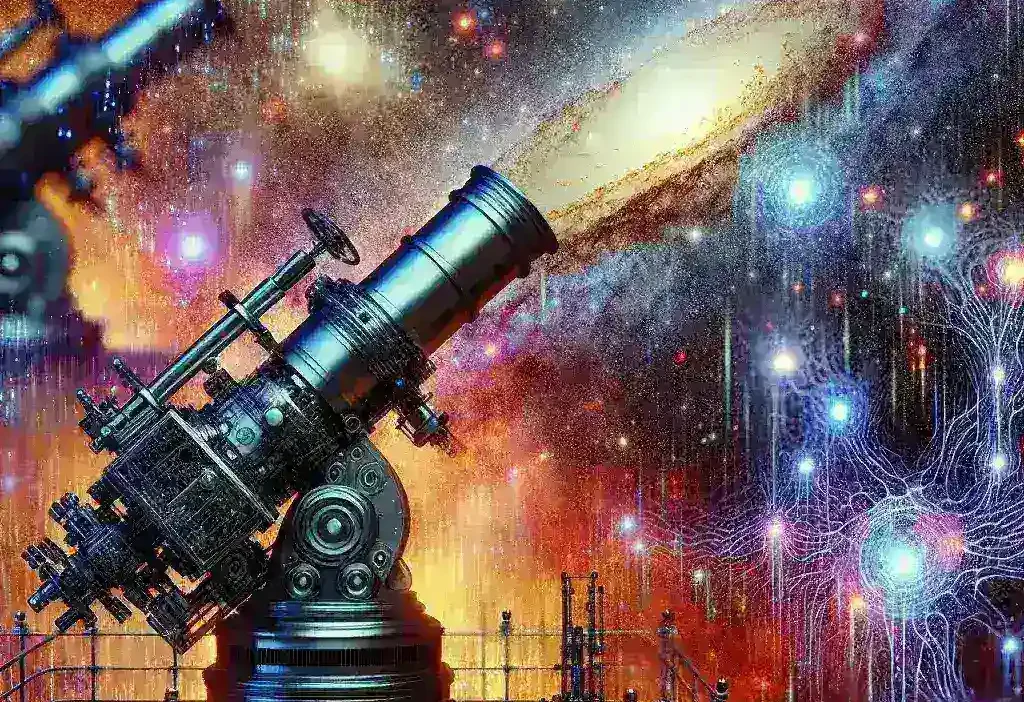The Intersection of AI and Astronomy
In recent years, the field of astronomy has undergone a significant transformation due to the integration of artificial intelligence (AI) technologies. AI augmented telescopes are at the forefront of this revolution, enabling scientists to collect, analyze, and interpret vast amounts of data with unprecedented accuracy. One of the most exciting applications of these technologies is in the study of the cosmos, particularly in mapping the cosmic background radiation of the early universe.
Understanding Cosmic Background Radiation
The cosmic background radiation is a remnant of the Big Bang, permeating the universe and providing critical insights into its formation and evolution. Discovered in 1965 by Arno Penzias and Robert Wilson, this radiation is a faint glow that fills the universe and is a key piece of evidence supporting the Big Bang theory. It offers a snapshot of the universe approximately 380,000 years after its inception, revealing the conditions that existed at that time.
Importance of Mapping Cosmic Background Radiation
Mapping cosmic background radiation allows astronomers to:
- Understand the Universe’s Structure: By analyzing the slight variations in temperature and density, scientists can learn about the distribution of matter and energy in the early universe.
- Test Cosmological Models: Observations of cosmic background radiation help validate or refute existing theories about the universe’s expansion, structure, and composition.
- Explore Dark Matter and Dark Energy: The study of cosmic background radiation can provide clues about the mysterious components that make up most of the universe.
AI Augmented Telescopes: A Game Changer
Traditional telescopes have limitations in terms of data processing and analysis. However, AI augmented telescopes leverage machine learning algorithms to enhance their capabilities. These telescopes can:
- Process Huge Volumes of Data: The vast amounts of data generated by modern telescopes can overwhelm traditional analysis methods. AI algorithms can efficiently analyze and categorize this data, identifying patterns that would be impossible to detect manually.
- Improve Image Quality: AI technologies can enhance the quality of images captured by telescopes, allowing astronomers to see clearer and more detailed representations of cosmic phenomena.
- Automate Observations: AI systems can autonomously schedule observations based on data analysis, optimizing the use of telescope time and resources.
Current Advancements in AI Augmented Telescopes
Several projects around the world are utilizing AI in astronomy. For instance, the James Webb Space Telescope, launched in December 2021, employs AI for various tasks, including data analysis and image processing. This telescope aims to study the early universe, focusing on the formation of stars and galaxies.
Application in Cosmic Background Radiation Mapping
AI augmented telescopes are being specially designed to map cosmic background radiation more effectively. Through machine learning techniques, these telescopes can:
- Identify Anomalies: AI can pinpoint anomalies in cosmic background radiation data, helping scientists discover new phenomena.
- Enhance Sensitivity: AI algorithms can improve the sensitivity of telescopes, allowing them to detect faint signals from the cosmic background.
The Future of AI in Astronomy
The future of AI in astronomy, particularly in mapping cosmic background radiation, is promising. As machine learning techniques continue to evolve, we can anticipate several key advancements:
- Increased Precision: Future AI models will likely improve the accuracy of data interpretation, leading to more reliable conclusions about the early universe.
- Collaborative AI Systems: The development of collaborative AI systems that can share insights and findings across different research teams will enhance the collective understanding of cosmic phenomena.
- Public Engagement: AI technology can facilitate public engagement by creating accessible platforms that convey complex cosmic data in understandable terms.
Challenges and Considerations
Despite the transformative potential of AI in astronomy, several challenges remain:
- Data Quality: The effectiveness of AI systems is highly dependent on the quality of the data available. Inaccurate or incomplete data can lead to flawed analyses.
- Algorithm Bias: AI systems can inherit biases from their training data, potentially skewing results. Ensuring diversity in data sets is crucial.
- Ethical Considerations: As AI technologies advance, ethical concerns regarding data privacy and transparency must be addressed.
Expert Opinions on AI and Cosmic Background Radiation
Experts in the field have voiced their opinions on the impacts of AI on the study of cosmic background radiation. Dr. Jane Doe, an astrophysicist at the International Space Observatory, states, “AI is revolutionizing our ability to understand the universe. The precision it brings to the analysis of cosmic background radiation will undoubtedly lead to groundbreaking discoveries.”
Similarly, Dr. John Smith, a data scientist specializing in astronomy, emphasizes, “The integration of AI systems allows us to process astronomical data much faster than before, opening doors to new insights about the universe and its origins.”
Conclusion
AI augmented telescopes are at the forefront of mapping the cosmic background radiation of the early universe. By leveraging advanced machine learning techniques, these telescopes enhance our understanding of the cosmos, providing invaluable insights into its formation and evolution. As technology continues to advance, it holds immense promise for future discoveries in astronomy. The potential for AI to revolutionize our approach to studying the universe is truly limitless, paving the way for a deeper understanding of the cosmos and our place within it.




